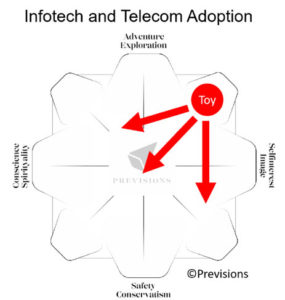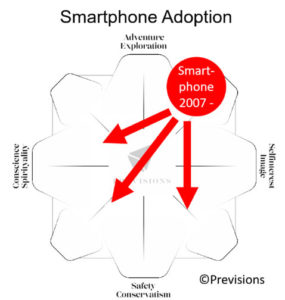Individual personality profiles – In depth
Brands navigating the market for increased sales, better margins and improved consumer stickiness to the brand. Success is dependent on deep consumer insights and ability to execute on these insights. Markets are increasingly complex as well as unpredictable and organizations need an agile mindset to adapt to unforeseen developments. At the same time building and evolving a brand is a delicate matter of consistency.
To get a competitive advantage in a B2C business precise timely insights in consumer desires, needs and demands are critical.
Customer profiles are intended to address this challenge. To excel every customer has two profiles.
The first view, the strategic personality profile is stable. This means that consumers’ personality profiles do not change significantly in a normal business cycle (change is slow and hard to induce). Likely change is so slow and insignificant that it is commercially not viable to try to change people’s personality profile. The personality profiles rather create a strategic dimension to be navigated from brand and communications perspective. The strategic view helps to identify key long-term aspects in peoples’ resonance with a brand. The purpose with the personality profile is to understand why people are doing things and to predict and influence how, what and why people might change behavior and adopt new services near time.
The second view is the tactical behavioral customer profiles. The intention here is to understand usage profiles and to influence people’s consumption. Service packages are adopted and optimized to people’s current and expected needs. This is done to increase revenues, margins and loyalty.
Together the two profiles create unique precise and agile individual consumer insights that bring you better competitiveness through improved more timely campaigns and better-aligned offerings. Short term campaign efficiency can improve some hundred percent. Midterm marketing efficiency even more, as you will gradually increase your capability to augment your offering and predict demand.
These individual customer profiles will speed up and refine the feedback loop. Continues learning through fast accurate feedback will bring you closer to your customers and help you become truly customer centric. They will enable you to address every single customer on a personal level with an offering that you know your customer need in a tonality you know is appealing.
In the following section, we will go through Customer Personality profiles in depth.
Individual Personality Profiles
[Customer Personality Profile] = f2([Individual Record], [Rich Data], [Market Research], [Transactional Customer Profile])
The most long-lived perspective of a customer is the customer’s personality. A customer’s personality comes from human values and attitudes. The values (psychographics) are individual deeply held norms, personality, and guidelines. These are shaped over many years and mainly during childhood. Values stay stable over a long time. They stay as core influencers in the customer journey, particularly for achieving strong advocating customer relations. Attitudes are more our direct personal views of contemporary life phenomena. Attitudes are formed by the close encounter between our values and the current context.
Depending on personality individual consumers navigate life in different ways. Some people love change and innovation, have a flexible mindset, are eager to get the most out of life. Other people believe their present situation is more acceptable than what may come tomorrow, the latter want calm water and have a clear opinion of how things should work and are less flexible to change. Some individuals have strong concerns for others and believe in equality for everybody, while other individuals are me-oriented with strong individual desires and a strong appetite for personal pleasure.
Personality profiles is a cornerstone of Rich Data. Personality profile reveals peoples’ motives and design preference, it also guides campaign tonality. Rich Data is important to the success of your analytics. Big data without aggregated market research is like cooking food without spices, it maybe keeps you alive but your brand will not flourish nor prosper. Customer personality profiling is about the spices. Adding 10 KB market research data to 100 TB big data can make billions of dollars’ bigger difference than another 100 TB big data.
Above multidimensional personality space is built from some 20 key consumer forces. To operationalise these deep insights of the customers we reduce the information into a 2-dimensional market map. A two-dimensional map of peoples’ personality in relation to consumption and acceptance of new ideas and concepts.
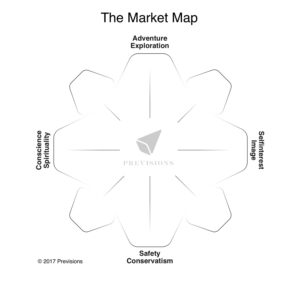 First vertical axis differentiates adventurous and explorative people that are positive to change and innovation from conservative people focused on safety and with a less flexible mindset.
First vertical axis differentiates adventurous and explorative people that are positive to change and innovation from conservative people focused on safety and with a less flexible mindset.
The second horizontal axis differentiates conscious and spiritual individuals that have strong concerns for others and believe in equality for everybody from individuals that are me-oriented with strong individual desires and with strong self-interest and appetite for personal pleasure.
Likely you have seen similar maps before. It’s however unlikely those maps were built for an agile capture of the market in real time. Because of this focus on operability, the map scientifically is built drastically different to how traditional market maps are built. Previsions map is named Life Value+. Through the formula
[Customer Personality Profile] = f2([Individual Record], [Rich Data], [Market Research], [Transactional Customer Profile])
every single customer gets a unique position on the vertical as well as the horizontal axes (X and Y coordinate) of the map. It’s these X and Y coordinates that are calculated by this customer personality formula.
The customer profiles can be predicted for every single customer and prospect. This way we create a very operational, powerful and adaptive customer analytics solution.
The X and Y coordinates can have any value between its min and max. For a typical market, you have people distributed everywhere on the map.
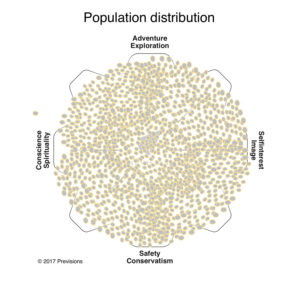 In simple terms, 25 % of the population is found in each quadrant of the map. You will find the younger population dominating northeast, and the elder the southwest. Middle aged is distributed all over.
In simple terms, 25 % of the population is found in each quadrant of the map. You will find the younger population dominating northeast, and the elder the southwest. Middle aged is distributed all over.
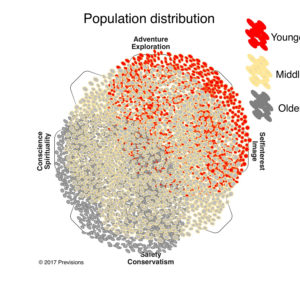
Early adopters
People positive to change as well as innovation and who have flexible mindsets, eager to take the risks of being first to get the chance to harvest on the next exciting step are found in the north.
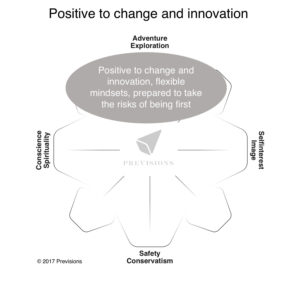 The value of an innovative brand like Apple comes from its ability to emotionally and rationally attract people with the early adopter personality found in the north of the map. Traditionally such adoption has been based on a lot of guesswork “gut feeling”. Marketers had to use their experience because actual feedback from the market on how well and how timely the campaigns hit the intended new target groups came too late for the marketers to be able to tune.
The value of an innovative brand like Apple comes from its ability to emotionally and rationally attract people with the early adopter personality found in the north of the map. Traditionally such adoption has been based on a lot of guesswork “gut feeling”. Marketers had to use their experience because actual feedback from the market on how well and how timely the campaigns hit the intended new target groups came too late for the marketers to be able to tune.
Lasting versus Instant
Some people have high concerns for inclusiveness, lasting benefits, convenience and sustainability. These are found in the west of the market map (the blue field).
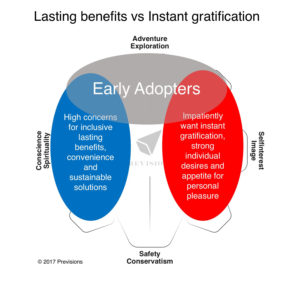
Other people impatiently want instant gratification, have strong individual desires and a healthy appetite for personal pleasure. These are found in the east of the map (the red field).
North East of the Market Map is the natural start for the adoption of completely new so far unknown TOY concepts. The more playful and the more revolutionary the more likely the first adopters of new infocom TOYs will be found in North East. To increase the likelihood of successful adoption the offer should be tailored for the TOY adopters. This includes product composition as well as marketing messages.
Case studies
Let’s look at two concrete examples to further understand the market map.
Case Smartphone adoption
iPhone was not the first smartphone on the market, but when it hit the market in 2007 it really personalized what is a playful infotech TOY. Where its predecessors had failed, it excelled. The iPhone promised internet in your pocket/purse. The success was very much about the amazing user experience. App store and Apple opening up for APPs from anyone and anywhere gave a further wow-factor and stimulated an idea explosion. Multiple finger touch brought the instant gratification, color screen and revolutionary design further added the pleasure. The APPs also enabled spontaneity in the complex contexts of mobile use cases. At the same time, the concept still required significant imagination and wish to experiment from the users.
Case car adoption
Let’s take another example; cars. People buy cars for different reasons. Particularly premium car brands build their existence on differentiating their offering from the car as a utility.
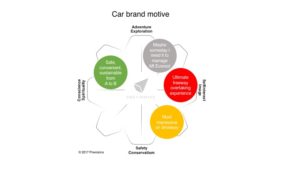
The horizontal dimension of the market map is here exemplified with the difference between considering the smartest, safest, most convenient sustainable way to go from point A to point B (green dot), versus looking forward to a driving experience in the vehicle of ultimate performance (red dot),
The case also shows the status triggers for the more conservative consumers in the southeast (orange dot) and the dream of the car that takes you and supports anywhere in the north of the map (gray dot).
Individual customer profiles – Timely address customers on a personal level with an offering that you know they need in a tonality that is appealing.
 Henrik Pålsson
Henrik Pålsson
Chief Visionary Officer
Previsions AB

